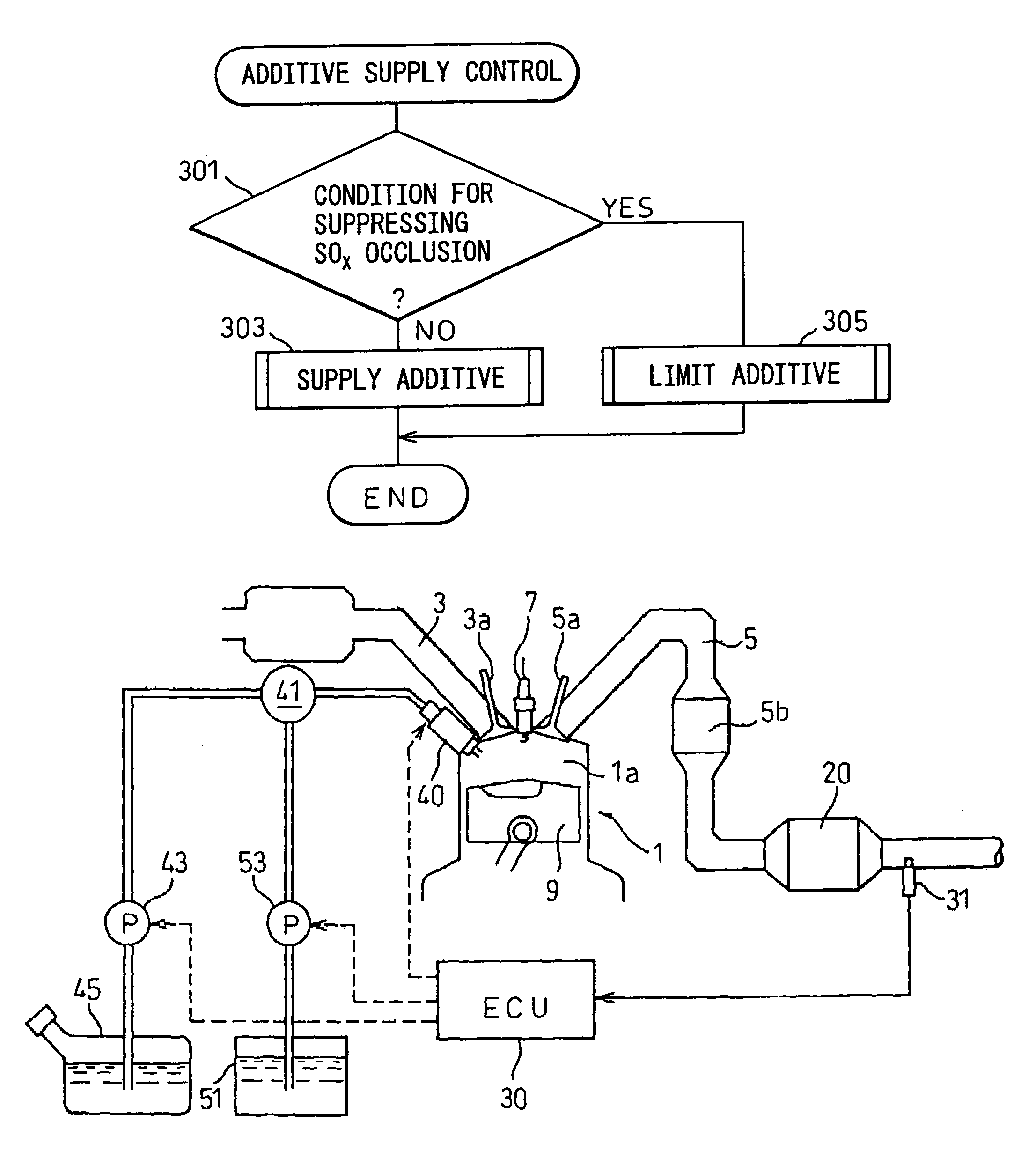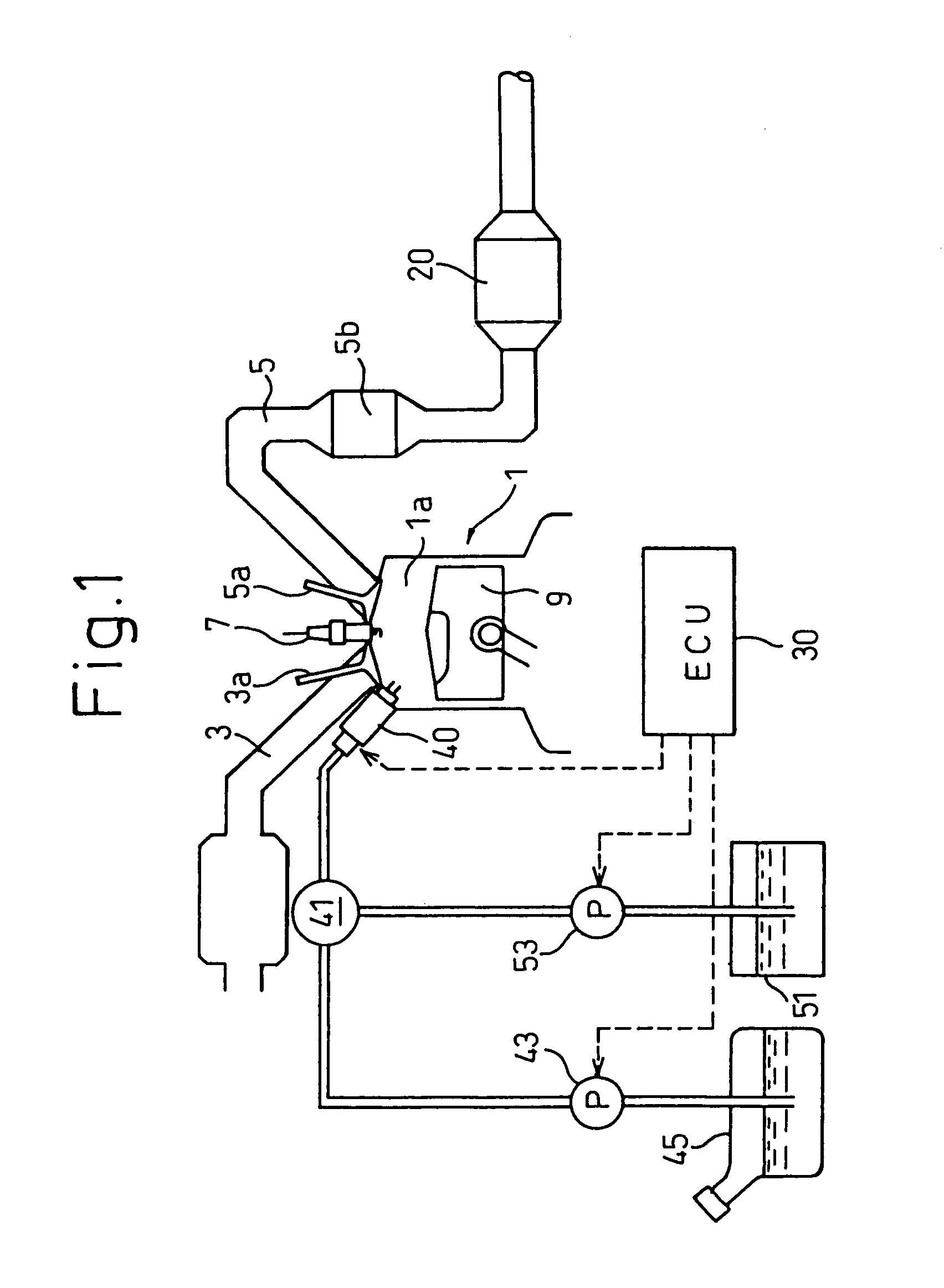Method of purifying exhaust gas of an internal combustion engine
a technology of internal combustion engine and purification method, which is applied in the direction of machines/engines, electrical control, separation processes, etc., can solve the problems of fuel consumption in increased amounts, sox contamination is not removed to a sufficient degree, and the purification capability of nox occluding and reducing catalyst drops, so as to reduce the consumption of sulfur-solidifying agent, reduce the consumption of nox, and suppress the increase of particulate matter
- Summary
- Abstract
- Description
- Claims
- Application Information
AI Technical Summary
Benefits of technology
Problems solved by technology
Method used
Image
Examples
first embodiment
(1)
[0068]In this embodiment, the sulfur-solidifying agent is supplied to the engine under a condition where the SOx can be easily occluded by the NOx occluding and reducing catalyst 20. Namely, the object of supplying the sulfur-solidifying agent to the engine is to prevent the occlusion of SOx by the NOx occluding and reducing catalyst 20. Under a condition where the SOx can hardly be occluded by the NOx occluding and reducing catalyst 20, there occurs no problem even if the sulfur-solidifying agent is supplied in a decreased amount or is not supplied.
[0069]In this embodiment, therefore, the sulfur-solidifying agent is not supplied or is supplied in a decreased amount under a condition where the occlusion of SOx by the NOx occluding and reducing catalyst 20 is suppressed to thereby decrease the consumption of the sulfur-solidifying agent and to suppress the formation of the particulate matter, formation of deposit and occurrence of knocking.
[0070]One of the conditions dominating th...
second embodiment
(2)
[0094]Next, a second embodiment of the invention will be described.
[0095]In the above-mentioned embodiment, the supply of the sulfur-solidifying agent to the engine was controlled depending upon the condition of atmosphere of the NOx occluding and reducing catalyst. In this embodiment, however, the sulfur-solidifying agent is not supplied to the engine or is supplied in a decreased amount under the condition where the SOx is released from the NOx occluding and reducing catalyst.
[0096]In a state where the occluded SOx is released from the NOx occluding and reducing catalyst as described above, the SOx in the exhaust gas is not occluded by the NOx occluding and reducing catalyst even when the gaseous SOx is contained in the exhaust gas.
[0097]In this embodiment, therefore, the sulfur-solidifying agent is not supplied or is supplied in a decreased amount under the condition where the SOx is released from the NOx occluding and reducing catalyst 20 thereby to decrease the consumption o...
third embodiment
(3)
[0115]Next, described below is a third embodiment of the present invention. In the above first and second embodiments, the consumption of the sulfur-solidifying agent was decreased and the formation of the particulate matter was suppressed by not supplying the sulfur-solidifying agent or by supplying the sulfur-solidifying agent in a decreased amount when the NOx occluding and reducing catalyst was under a condition where the SOx was hardly occluded.
[0116]In this embodiment, on the other hand, the occlusion of SOx by the NOx occluding and reducing catalyst is permitted to some extent within a range in which there is no drop in the NOx purification efficiency which is the principal function of the NOx occluding and reducing catalyst.
[0117]The NOx occluding ability of the NOx occluding and reducing catalyst varies depending upon various factors such as the catalyst temperature, amount of NOx occluded in the catalyst, deterioration of the catalyst (inclusive of sulfur contamination)...
PUM
 Login to View More
Login to View More Abstract
Description
Claims
Application Information
 Login to View More
Login to View More - R&D
- Intellectual Property
- Life Sciences
- Materials
- Tech Scout
- Unparalleled Data Quality
- Higher Quality Content
- 60% Fewer Hallucinations
Browse by: Latest US Patents, China's latest patents, Technical Efficacy Thesaurus, Application Domain, Technology Topic, Popular Technical Reports.
© 2025 PatSnap. All rights reserved.Legal|Privacy policy|Modern Slavery Act Transparency Statement|Sitemap|About US| Contact US: help@patsnap.com



